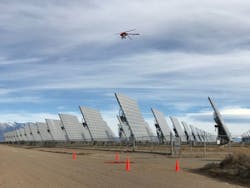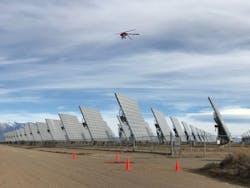Xcel Energy to fly unmanned helicopter beyond line of sight, a first under FAA waiver, to inspect infrastructure
MINNEAPOLIS. Xcel Energy, a utility company using unmanned aircraft system (UAS) or drone technology to inspect energy infrastructure, is on track to become the first utility in the nation to routinely fly unmanned aircraft beyond the operator’s line of sight when it begins surveying transmission lines near Denver, Colorado. To conduct the flights, the company is working with several industry leaders, including Harris Corp., Phoenix Air Unmanned LLC, Altus Intelligence, and researchers from the University of North Dakota, host to the FAA authorized Northern Plains UAS Test Site.
Federal Aviation Administration (FAA) officials authorized the flights by approving a waiver. Xcel Energy officials call the FAA’s decision “unprecedented in the utility industry” and an historic first.
Starting this summer, Xcel Energy will routinely operate UAS beyond visual line of sight (BVLOS) within a designated area approximately 20 miles north of Denver International Airport (DIA). Licensed pilots will remotely operate a small, unmanned helicopter weighing less than 55 pounds. Xcel Energy will use advanced command-and-control technology to ensure safe operations while it inspects transmission lines.
When the transmission inspections are completed in the Denver area, Xcel Energy will work with the FAA to extend beyond line-of-sight operations in other states where the company provides electric service.
“Xcel Energy is honored to be the first utility to conduct flights that will enhance grid reliability and safety for our employees and the public,” says Ben Fowke, chairman, president, and CEO, Xcel Energy. “With this groundbreaking decision, we are advancing the use of technology that improves our efficiency and provides cost savings for our customers.”
For several years, Xcel Energy has been collaborating with the FAA to develop operational and safety requirements for unmanned aircraft operations in the utility industry. Most recently, in January 2017, Xcel Energy entered into a Partnership for Safety Program (PSP) with the FAA to operate drones for power line inspections within visual sight of operators. The work demonstrated how unmanned aircraft improve productivity and safety as the technology allows for inspections to be completed without the use of trucks, helicopters or other utility equipment. Xcel Energy inspects more than 320,000 miles of electricity and natural gas infrastructure to ensure the safety and reliability of its energy system.
Xcel Energy (NASDAQ:XEL) provides the energy that powers millions of homes and businesses across eight Western and Midwestern states. Headquartered in Minneapolis, the company is an industry leader in responsibly reducing carbon emissions and producing and delivering clean energy solutions from a variety of renewable sources at competitive prices.
At Xcel Energy, unmanned aircraft systems (UAS) – commonly known as drones – are being integrated into operations to enhance public and worker safety, improve reliability to customers, and capture maximum efficiency gains.
The company’s UAS Program Office works within the company to deploy the technology across operations. Some examples include inspections of transmission lines, substations, gas pipelines, power plant boilers, wind farm components, and other applications.
UAS “proof of concept” missions over the past two years have demonstrated that UAS technology can enhance inspection and maintenance processes, potentially reducing customer cost and improving response times.
The company operates and inspects 320,000 miles of electricity and natural gas infrastructure, thousands of substations, and dozens of power plants in the eight states it services. While UAS are not expected to completely replace other inspection methods, they will be an essential tool. In a variety of circumstances, UAS have advantages over trucks, helicopters, or fixed-wing aircraft, and they provide improved safety for workers, greater efficiencies, and flights that are less intrusive to communities.
When the FAA began allowing the commercial use of drones, it granted waivers that required drones to be operated within the operator’s line of site and within 200 feet of the ground. In 2015, Xcel Energy received the needed FAA permissions to fly several research flights beyond those levels, becoming the first utility to conduct a “beyond line of site” UAS mission. Those flights have provided valuable data.
In Mayville, North Dakota, alongside a team of researchers, Xcel Energy is conducting a series of test flights and analyses as part of a year-long research project. That involves staging disaster scenes that typically cause power outages to test the best way to survey and assess damage to restore service.
The research involves using two types of UAS – a large, high-altitude drone and a low-altitude drone. Both devices will be equipped with cameras, advanced data modeling, and analysis technologies.
The project is expected to further demonstrate the value of drones when disaster strikes to enhance public and worker safety, reduce outage restoration times, and limit disruption and costs to customers and communities.
The research partnership includes Xcel Energy, the University of North Dakota, Elbit Systems of America, General Electric, Northern Plains UAS Test site, and others.


